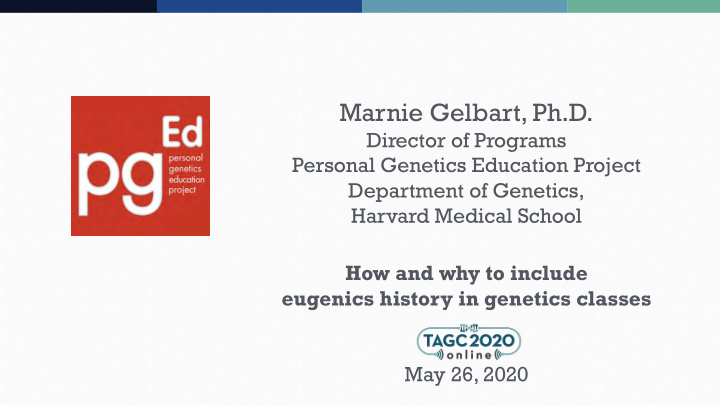



Marnie Gelbart, Ph.D. Director of Programs Personal Genetics Education Project Department of Genetics, Harvard Medical School How and why to include eugenics history in genetics classes May 26, 2020
pgEd (past & present) Scientists, social scientists, educators, and community organizers
Online Curricula • Consumer genetics • Personalized medicine • How does ancestry testing work? • Genetic discrimination & GINA In Progress: • DNA, crime, and law enforcement • Sex, athletics, and genetics • Reproductive genetic technologies • Informed consent in the genomic age • Genetics, history, & the American eugenics movement • Ancestry, race, and DNA • Using primary sources to examine the history of eugenics • Genome editing and CRISPR • Birth of CRISPR-edited twins • Genome editing and the environment pged.org/lesson-plans
Why is learning about the American eugenics movement useful when studying genetics? Present Past Future What was the US How do we access What are the new eugenics movement the benefits and medical advances and who was reduce the harm in and ethical issues in impacted? genetics? genetics?
American Eugenics Movement What was the American eugenics movement and who was impacted? Eugenic ideology Art Credit: Gabriel Orozco, Light Signs #3 (Korea) (1995), Medium: light box, plastic sheet, vinyl decals. Dimensions” 39-3/8 x 39-3/8 x 7-3/4 inches Collection Walker Art Center, Minneapolis. T. B. Walker Acquisition Fund, 1996. Play clip from The Gene: An Intimate History Legal implementation (courtesy of WETA) pbslearningmedia.org/collection/kenburnsclassroom/film/the-gene
“Fitter Family” contests: 1920s-1940s Georgia State Fair 1924 Photo: 1924. Source: American Philosophical Society, ERO, MSC77,SerVI,Box 4, FF Studies, KS Free Fair
8-1 Supreme Court ruling: Buck v. Bell allows forced sterilization (1927) “…society can prevent those who are manifestly unfit from continuing their kind… Photo by A.H. Estabrook, 1924. Source: Arthur Three generations of Estabrook Papers, Special Collections & Archives, University at Albany, SUNY. imbeciles are enough.” -Justice Oliver Wendell Holmes, Jr. US Library of Congress Quote source: Buck v. Bell, 274 US 200 – Supreme Court 1927
Pedigrees used to justify sterilization Photo: circa 1935. Source: The Harry H. Laughlin Papers, Truman State University, Lantern Slides, IBM Box,Box 10
American eugenics and German Nazism Nazi Propaganda “We do not stand alone”
Indigenous people in the US were targeted for forced sterilization U.S. Department of Health, Education and Welfare (via Akwesasne Notes Vol. 6 Number 5)
Madrigal v. Quilligan advances the cause of informed consent • Latinx women in California were sterilized without consent or under coercive circumstances, such as being in active labor. • They sued the doctors and hospital where they were sterilized. They did not win the 1978 case, but it was a catalyst for social and legal change. • New practices implemented at the hospital: No longer threatening to take away welfare o benefits if woman refused sterilization. Consent forms translated into several languages. o Waiting periods for women to weigh their options. o
Secretly sterilized at age 14, Elaine Riddick successfully fought for recognition and compensation in North Carolina Watch an Associated Press 3-minute long video about Elaine Riddick: https://www.youtube.com /watch?v=IWanJoxW2s4 &t=10s Photo permission via Adam David Kissick, https://www.adamkissick.com
Why is learning about the American eugenics movement useful when studying genetics? Present Past Future What was the US How do we access What are the new eugenics movement the benefits and medical advances and who was reduce the harm in and ethical issues in impacted? genetics? genetics?
Engaging our communities There is almost no scientific discovery of any import that I can think of that hasn’t had the capacity for both good and ill. And it’s going to take wise societies to direct those discoveries down the right path and away from the wrong path. - Shirley Tilghman, from The Gene
Thank you!
Recommend
More recommend